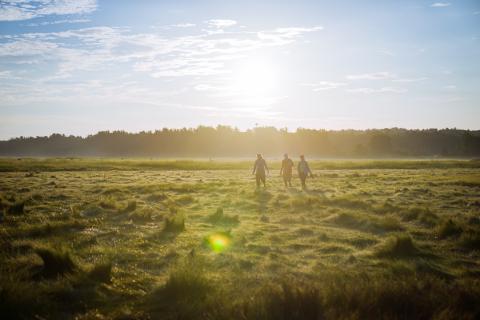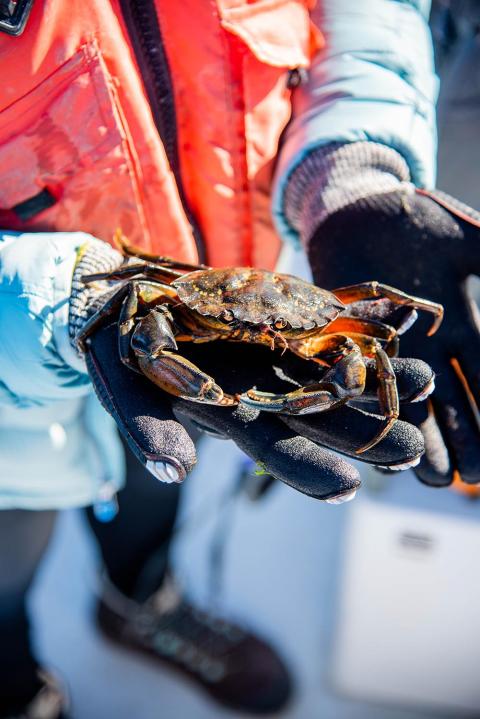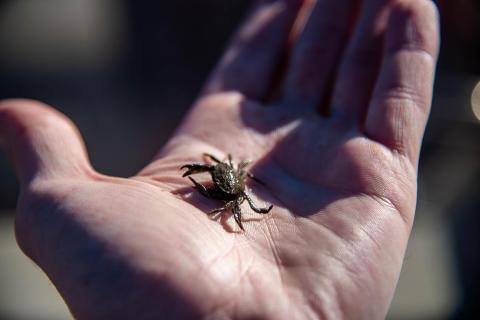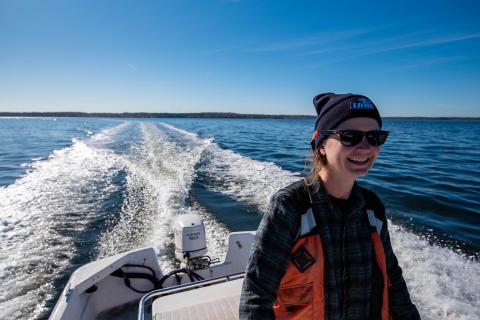Graduate Student Feature: Meyer Investigates What Green Crabs Mean for Our Oysters

Ten years ago, it would have been hard to imagine close to 30 aquaculture sites would one day dot New Hampshire’s Great Bay – back then, there were only two.
The industry’s dramatic growth over the past decade has been a collaborative effort between scientists and state agencies dedicated to improving both the ecosystem and the economy through oyster reef restoration and expanded shellfish aquaculture.
Kelsey Meyer, a 2022-23 New Hampshire Sea Grant Graduate Fellow, is a third-year marine biology Ph.D. student at UNH and coordinator of the NH Shellfish Farmers Initiative. Meyer is confident her research on invasive green crabs in Great Bay will provide valuable insights into a species that could wreak havoc on the sustainability of New Hampshire’s oyster farms.

Green crabs, everywhere
Green crabs, found in overwhelming numbers all along the East Coast today, are native not to North America, but to Europe. Also called the European green crab, this small crustacean likely hitched a ride from its home continent aboard merchant ships in the mid-1800s.
Green crabs are ecologically destructive and greedy consumers of oysters and other shellfish, a reputation that makes oyster farmers especially concerned by their abundance.
“I sent out a survey to the farmers a year and a half ago,” Meyer says. “A lot of responses were, ‘Green crabs are all over our farms, we want to know what they’re eating. Are they eating oysters?’” Meyer, who works under Dr. Bonnie Brown at UNH’s Ecological Genetics Laboratory, is studying the quantity, distribution, and diet of green crabs to try and provide some answers.
A closer look at the green crab problem
While smaller monitoring surveys have been done in the past for green crabs in the bay, Meyer is the first to conduct large-scale monitoring and trapping in almost a decade. Her method of catching crabs is equal parts simple and effective: she fills stainless steel tea balls with herring paste that draws in crabs but prevents them from ever actually eating the bait.
Every two to three days for the first six months of research, Meyer took her small boat out on the bay to set bait, pull up traps, and take stock of her haul. Now back on shore, she’s started dissecting crab stomachs to conduct metagenomics panels and oyster PCR tests, which will allow her to identify what the green crabs are eating and how much of their diet includes oysters.
The results so far show green crabs from different sites (reef and farmed) are indeed consuming oysters in Great Bay as part of a mixed, scavenger-like diet: “Baseline data is showing that [green crabs do] have the potential to be destructive, not only for restoration areas but for farms,” Meyer says. She will continue to investigate green crab stomach contents to gain a better understanding of food web dynamics and their diet in Great Bay.

How research impacts oyster farms and restoration
Krystin Ward, Supervisor of Laboratory Research at UNH’s Jackson Estuarine Laboratory and owner/operator of a 5.5-acre farm in the bay, has been working on oyster restoration projects in the area for over 15 years. Much of her efforts focus on improving the health of badly degraded reefs by laying out substrate for oyster larvae and seeding juvenile oysters to encourage new growth.
As both a researcher and a farmer, Ward has seen firsthand the threat green crabs pose in the bay to both restoration and farming. “We’re seeing them all the time,” she says. “Kelsey’s findings recently have been very important for us – her research is showing us how big the oysters need to be to avoid predation and the type of gear we should use.”
Spearheading the NH Shellfish Farmers Initiative allows Meyer to collaborate with farmers on her research and provide baseline data that will add to best management practices, information she has already shared with the Piscataqua Regions Estuaries Partnership (PREP) that could eventually extend beyond New Hampshire and Maine.
An unexpected discovery

It’s evident that green crabs are spawning in huge numbers in the bay, but this past September, UNH doctoral student Alyssa Stasse and technician Emily Williams were checking Meyer’s traps and stumbled on something they didn’t expect to find: a pair of mated blue crabs.
Blue crabs are found all along the Atlantic Coast and in the Gulf of Mexico, but as a warm-water species, it’s less common to find them as far north as New Hampshire. That’s what makes evidence of mating blue crabs in Great Bay even more remarkable – and concerning. If these breeding blue crabs are able to maintain a larger population, it could present even more issues for the area’s oysters.
Meyer plans to run a diet analysis on the blue crabs she caught this past season and compare it with the green crab data to determine if one species is more heavily targeting oysters. From what she’s seen so far, there’s reason to believe blue crabs are after green crabs as well: “Usually, I’m pulling up a couple hundred green crabs,” Meyer says. “When I saw a blue crab in the trap, there were only three to four green crabs.”
Will blue crabs dominate Great Bay?
According to Ward, adding blue crabs to Great Bay has the potential to turn the oyster industry “upside down,” making farming more expensive, labor-intensive, and time-consuming due to the extra processes and gear required to protect the oysters.
“Depending on how big of an oyster they can get their hands on, we could be a lot more gear-intensive,” she says.
To better understand the possible effects, Meyer will conduct a predator-prey experiment this spring to study the interactions between blue crabs, green crabs, and oysters, observing what happens when all three species are in a cage together. Aside from the knowledge that blue crabs do eat oysters, there are many unknowns, including the possibility that instead of eating oysters, blue crabs will hunt green crabs. Blues could also end up fighting against the greens for the same prey.
As the nature of the relationships unfold, the results could create some complex situations. “It would be great to have a really high predator on green crabs,” Meyer says. “But at the same time, blue crabs could decimate the oysters even more because they can swim and go through the water column. I’m excited to see what we find this spring and summer.”
Moving toward a solution
For the time being, Meyer’s primary research focus remains on green crabs to help improve oyster farming and restoration. An important component of solving the green crab problem includes population control, which she believes hinges on the creation of a commercial market and fishery.
Currently, green crabs are mostly used as bait, but there are efforts underway through the NH Green Crab Project to explore the viability of harvesting soft-shell green crabs at scale and stimulate market demand. Meyer has collaborated with Dr. Gabby Bradt from New Hampshire Sea Grant on her work with both blue and green crabs in NH waters. For oyster farmers like Ward, adding green crabs to their licenses could help protect oysters and act as an additional revenue stream.
“The research has been invaluable,” Ward says. “Kelsey is pulling us together as a group, sharing her research, and getting the word out about our mission and what we’re doing for the bay. I see the oyster industry growing – we just need to find new ways to help it grow.”
LEARN MORE ABOUT OUR GRADUATE FELLOWSHIPS IN RESEARCH, POLICY, AND MORE
Story by Michelle Hennessey
Photos by Tim Briggs

